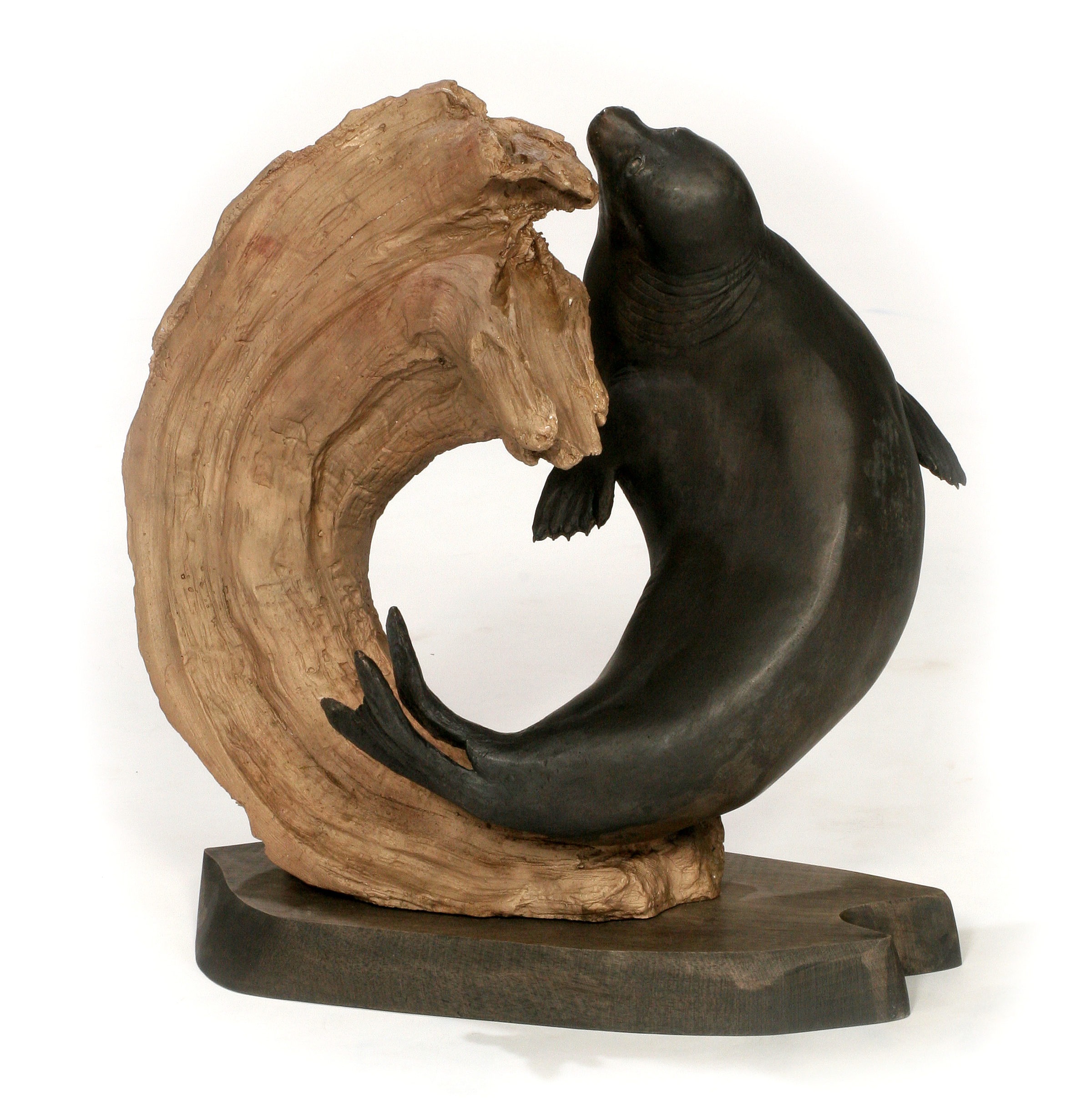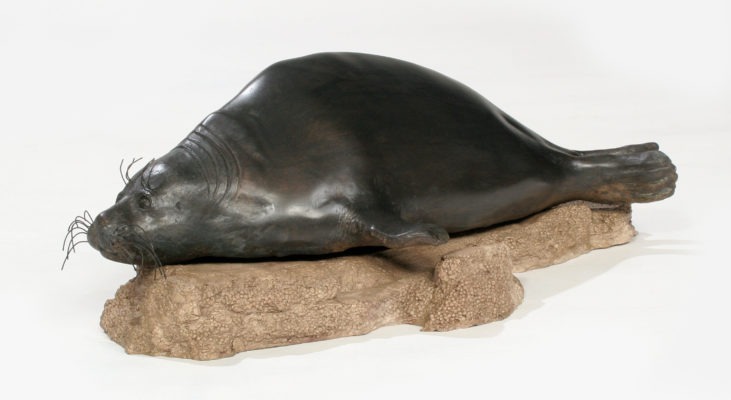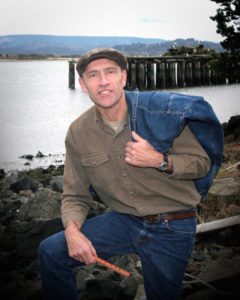For nature artists, the doors opened by up-to-date and futuristic technology are many. Options for wildlife observations have grown with stationary webcams, tiny cameras riding piggyback on wildlife subjects, remote controlled model airplanes [eco-drones] with video cams, and night vision-motion activated trail cameras. Some of these methods, like trail cameras, are easily available for an artist’s own research projects. Drones are the latest tool for accessing wildlife that is difficult to observe. Some models are now being used to monitor orangutan habitat in Indonesia, protect rhinos and elephants in Nepal, and to count chimps in Tanzania.
All of these new methods of wildlife observation points to a future of less human disturbances of the animals and their habitats, improving on the well-being of the natural world. An example in point and a method I personally followed and encouraged is a web cam installation in the wilderness of Siberia. This began with my artistic field study on Lake Baikal, Russia.
A career long interest in aquatic mammals initiated my proposal for an artistic field study of the freshwater Baikal Seals as a Flag Expedition, which is a study program of rare and endangered wildlife and their habitats sponsored by the Artists for Conservation Foundation. Besides being unique as the world’s only freshwater seal species, they reside in a land locked Siberian lake of extraordinary physical features.
The initial focus of the 2008 expedition was to actually locate and observe the animals. That is a daunting task for a species spending most of their lives in water, in one of the world’s largest lakes, and one that is surrounded by rugged wilderness. To assure close encounters with the species and for researching them, I enlisted the aid of key Lake Baikal entities: Zabaikalsky National Park and its nerpa habitat, Baikal Wave environmental organization, The Nature Museum of Irkutsk, and the Tahoe-Baikal Institute head quartered in Lake Tahoe, California.
Although Lake Baikal is vast, it also confines the seals, which is an opportunity to monitor them as an indicator pinniped species in the face of climate change and other impacts. Lake Baikal serves as a living laboratory representing all the world’s pinnipeds, which are far flung and difficult to study. Using this lake as a mechanism for monitoring pinnipeds coping with climate changes has another advantage. For over a century, Russian scientists have kept accurate records on climate and seal numbers and continue to monitor the seal’s well-being.

One project that I pledged to support, which was only conversation during my flag expedition visitations with the Limniological Institute and the remote seal habitat, has now become a reality. Scientists and biologists from the Lake Baikal Museum have installed a web cam on the remote Ushkanii Islands, where numerous Baikal Seals gather every summer and where my AFC artistic field study took place. The museum is now presenting real time video feeds of this seal rookery on large screens, which can also be viewed on their website. Their objective is for the world to see the only freshwater seals without traveling to their sensitive habitat, a method that could be helpful in protecting other species by limiting human disturbance.
Unfortunately, it is possible that rare and exotic wildlife in their own wild surroundings will become less accessible in the future. There are those who say too much eco-tourism access harms the environment, such as popular hiking trails of Nepal that become littered with trash. Too many people can love a critical habitat to death. More fragile wildlife areas are becoming off limits to human access as habitat diminishes, and in a new trend, sometimes replaced with webcam visuals for the public. This is the direction taken by Russian biologists and authorities at Lake Baikal’s Ushkanni Islands to protect their rare freshwater seals.
Such a progression is a double edged sword. On one hand, the Baikal island wilderness that I explored, devoid of any lights or cell phone towers on horizons in all directions, has been invaded with mechanical devices of wire and steel set in concrete. For most artists, nothing can substitute for “being out there.” Obtaining visual material that every nature artist utilizes is a challenging task, albeit usually an enjoyable task when in the field. Field work remains an important privilege for many artists, not only for observing, but also for living the experience and interacting with nature. The same breeze batting your face sets a bird into flight, as an artist attempts to grasp the full spirit of nature events.
On the other hand, visitors at the Baikal Museum, which is in the most populated fringes of the lake, can now access views of this wilderness and its rare wildlife subjects by virtue of this installation, a wind-powered webcam. Millions of people worldwide can now observe these rare seals in real time via the internet, without visiting or disturbing the actual site.
A similar project is planned on the Oregon Coast near my home and art studio. Simpson Reef hosts four species of pinnipeds that are closed off to public access and is particularly restricted during the harbor seal birthing season. Roadside sites with sweeping overviews of seal and whale activity are open to the public. About five miles from these reefs in the fishing village of Charleston, a new marine life museum has opened. Part of the long term plan for the University of Oregon center, and one which I hope to be involved in, is to connect pinniped activities to a museum viewing screen via webcam.
Since we are tossed about between the fine line of disturbing the wildlife that we revere and enjoying the access for observing them, the technology for observing from further distances may be a positive trend. More people will have the opportunity to enjoy nature and become more appreciative of the wonderful gifts of the natural world without leaving any footprints.
Terry J. Woodall [b. 1951] specializes in wood sculptures and bronzes of Northwest oceanic and woodland wildlife. Natural tree formations stir Terry’s imagination, resulting in leaping salmon, diving eagles and other wildlife subjects. Over thirty years creating art as a full time profession has resulted in thousands of fine carvings viewed and sold in dozens of galleries.
While Woodall works on creations of wildlife sculpture most of his working life, he also enjoys managing a small tree farm in his native Northwest, salmon fishing, adventure travel, and writing, all mixed in a blend of outdoor inspirations. His writings on wildlife art have been published in Wildlife Art Magazine, the Society of Animal Artists newsletter, Wildscape Magazine of Great Britain, the online Wildlife Art Journal, and his blog stories “Where on Earth”. Woodall is an Associate Member of the Society of Animal Artists. You can learn more about the process of bronze sculpting through this PDF and view Woodalls’s other work here.
This post is part of the MAHB’s Arts Community space –an open space for MAHB members to share, discuss, and connect with artwork processes and products pushing for change. Please visit the MAHB Arts Community to share and reflect on how art can promote critical changes in behavior and systems and contact Erika with any questions or suggestions you have regarding the new space.
MAHB Blog: https://mahb.stanford.edu/blog/webcams-on-wildlife/
The views and opinions expressed through the MAHB Website are those of the contributing authors and do not necessarily reflect an official position of the MAHB. The MAHB aims to share a range of perspectives and welcomes the discussions that they prompt.

